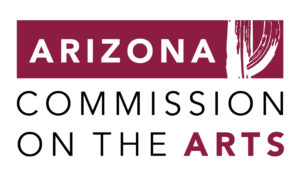The Huichol Culture of Mexico at Emerson Elementary School
An Artist Residency with Reggie Casillas and Gloria Martinez-Granados
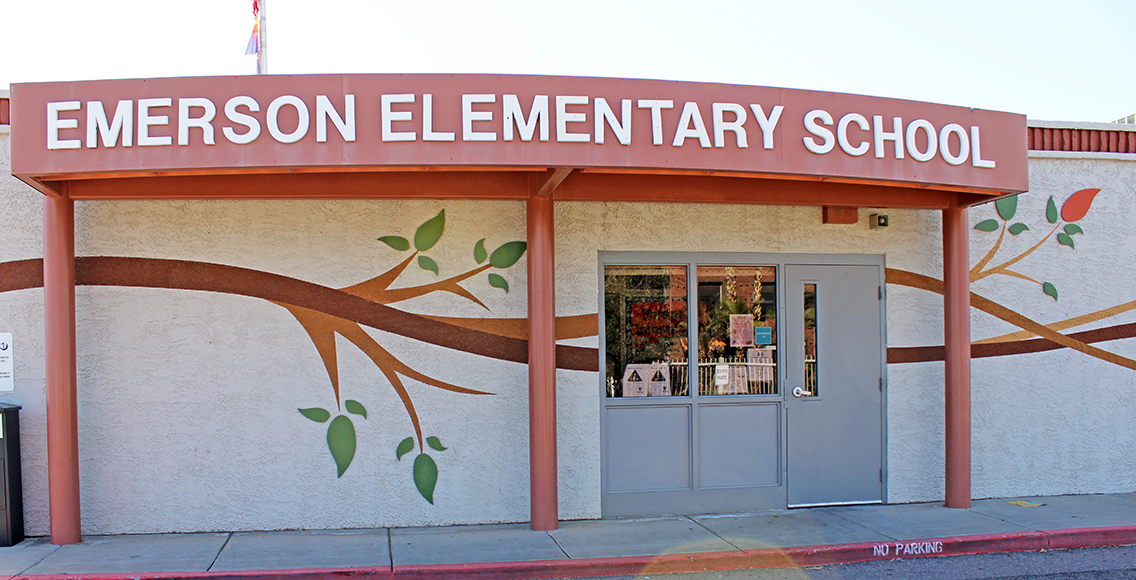
During school years 2020-2022, CAC teaching artists Gloria Martinez-Granados and Reggie Casillas partnered with art teacher Olivia Yuen to teach artmaking practices based in the Huichol Culture of Mexico. Year 1, the instruction was all online due to COVID restrictions. Year 2, Reggie and Gloria were able to join Ms. Yuen in the classroom.
Introducing the Huichol People and their Culture
To prepare students for art making, they were introduced the the Huichol culture through a video written and produced by Judy Butzine, CAC co-founder and community arts educator, with narration and music by Oliverio Balcells ("En los Valles del Sueño" 2020 and "Flauta y Campo" 2020). Oliverio specializes in the arts and culture of Mesoamerica.
Year 1
During the restrictions of COVID, students initially learned about the artmaking by video in the classroom with Olivia Yuen. Then they had a series of virtual sessions with the artists to further develop the ideas in the videos and create art.
The CAC delivered materials and supplies for the projects to Emerson. The beading materials were prepared in packets for individual students. Ms. Yuen then packaged all art materials together for parents to pick up for their students.
Classes were held over the internet, and documenting student work was complicated during this time. Each of the artists led students through an art activity and exploration of the Huichol culture of Mexico as it relates to their own art practice. Reggie Casillas demonstrated multiple ways to shade a drawing, and explained the significance of symbols and colors found in Huichol art. Students practiced these techniques on their own copy of a Two-Headed Eagle image created by Casillas.
Gloria Martinez Granados introduced the art of beading—an artistic tradition mastered by the Huichol people. She explained how non-traditional art materials can be used for beading and showed multiple ways that beading can be applied to create jewelry, adorn sculptures, or design on a loom. Students created their own beaded bracelet through this experience.
For the visual art projects in 2021, we weren't able to gather images of what the students created. Students were, however, invited to share what they learned. The types of comments received from students in Reggie's sessions included:
- I learned that each color that were on the drawings had a meaning.
- I learned how to shade/new ways to shade [many responses to this point].
- I learned to line my drawings.
- I learned more about Reggie Casillas [the artist].
- I learned how to make stuff darker.
- My biggest takeaway was the dotted shade because its very hard for me to do.
And after Gloria's sessions, typical comments included:
- I learned how to bead. I also learned that some patterns have story's behind the beaded work.
- I learned from Gloria the many ways to bead.
- Something I learned from her was that art is a good way to express your feeling and art is a good way to tell a story.
- I learned from Gloria Martinez-Granados is that she made a art that was basically inspired from TV. She heard that they called them people aliens [undocumented people].
- I learned that you can make drawing with seeds from a plant.
- My biggest takeaway was that I could use leaves and other things from nature to use as beads.
- My biggest takeaway was all of her separate arts because they were really really good.
Year 2, Spring 2022
Artists Gloria Martinez-Granados and Reggie Casillas were able to join students in the classroom this year and brought new art-making experiences.
Gloria Martínez-Granados, Paper Weaving
Gloria said of her paper-weaving activity:
"On the first day I introduced myself to the students and brought artwork, huipiles and beaded jewelry as examples and inspiration for the conversation and for the designs they would be getting ready to create. The school art teacher, Olivia Yuen and music teacher Emily Flathers helped to guide the students in explaining the technique, gathering materials and assisting them with weaving.

The students watched a short video in which I showed the entire process to weave with paper and discussed Huichol artwork and its inspiration and practice in contemporary art."

Image & Video Credit CALA Alliance | How I Became an Artista:
Paper Weaving Workshop with Gloria Granados-Martínez (2021)
Gloria continues, "Afterwards, we discussed symbols and color expression in Huichol artwork and how we can be inspired by it to create our own designs. We quickly got started in making pattern drafts for weaving the designs. We offered time for questions at the end of the session, 'When did you start making art?' 'How old were you when you migrated to the United States?' 'Where did you get the beaded jewelry?' The students asked questions and seemed to be interested, one of the students said “' like your art.'
On the second workshop day we guided the students to begin weaving their draft patterns created on the first session. Each student followed their pattern, selected colors for their design and weaved the papers together. Once completed, they glued down the paper to keep it secured. Weaving is a slow process, for some it can be frustrating and once you understand the pattern it can become a meditative practice. I hope that many of the students will continue to create using this technique and that many of them will be intrigued to continue learning about art and culture."
Students at Work Weaving Paper!
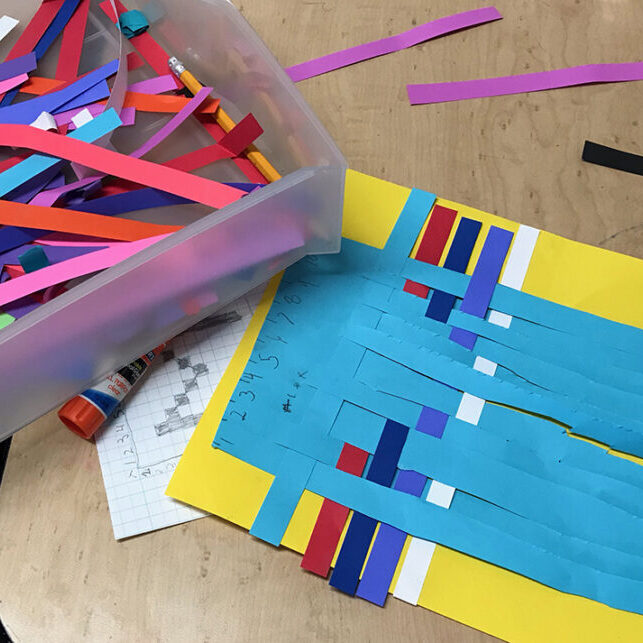

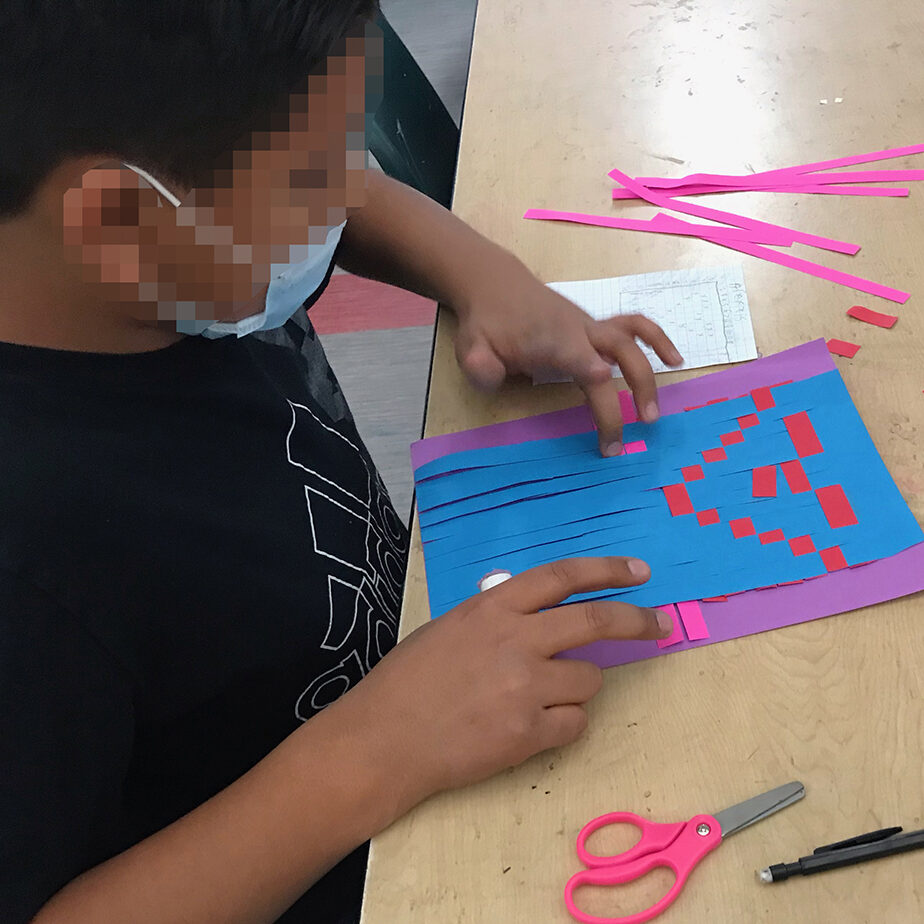

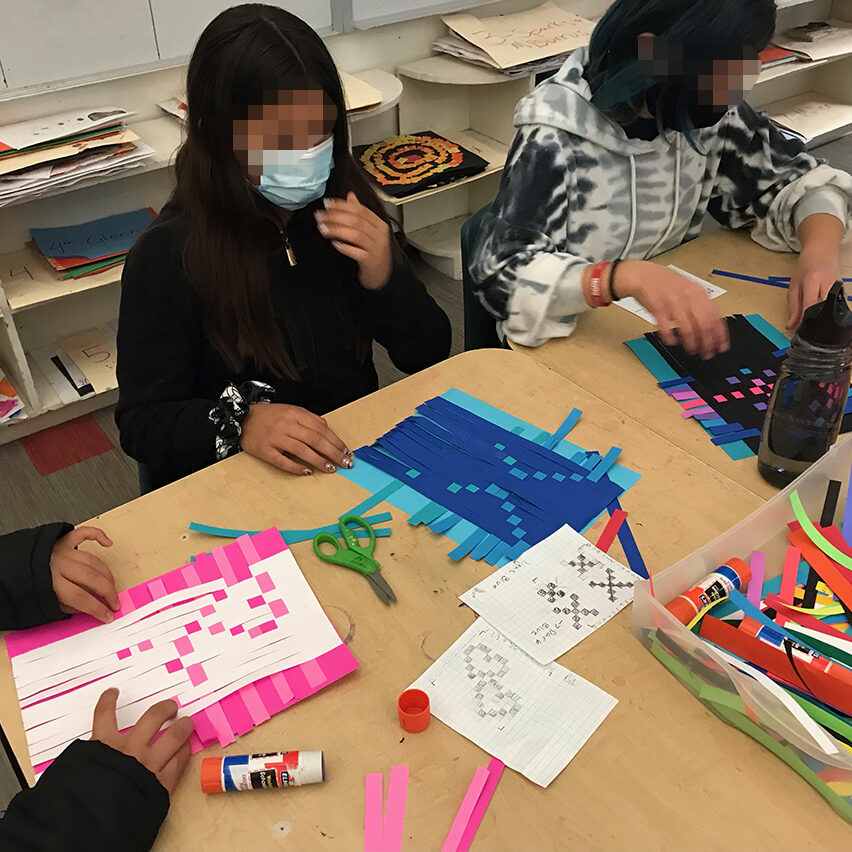

Reggie Casillas, Stenciling
Once again this year, artist Reggie focused on Huichol symbolism in collaboration with Olivia Yuen, art teacher. He helped students to connect the symbolism to their personal experiences. Reggie remarked:
"The Huichol Project with Emerson Elementary went well and I believe many students were impressed with the works of art they were able to create. Since the project utilized spray paint, I think it provided a new experience to students who were curious about the medium and most likely had not used it previously. Given the time frame we were able to work with, I found that many students chose to work collectively to streamline the use of the hand-cut stencils and popular colors. One thing that impressed me personally was a group of young girls who figured out how to use the stencils and create gradients between several colors. This was not a technique I had time to discuss and share, so I was happy to see that some experimentation led to some awesome artwork!
Student Symbols in Stencil
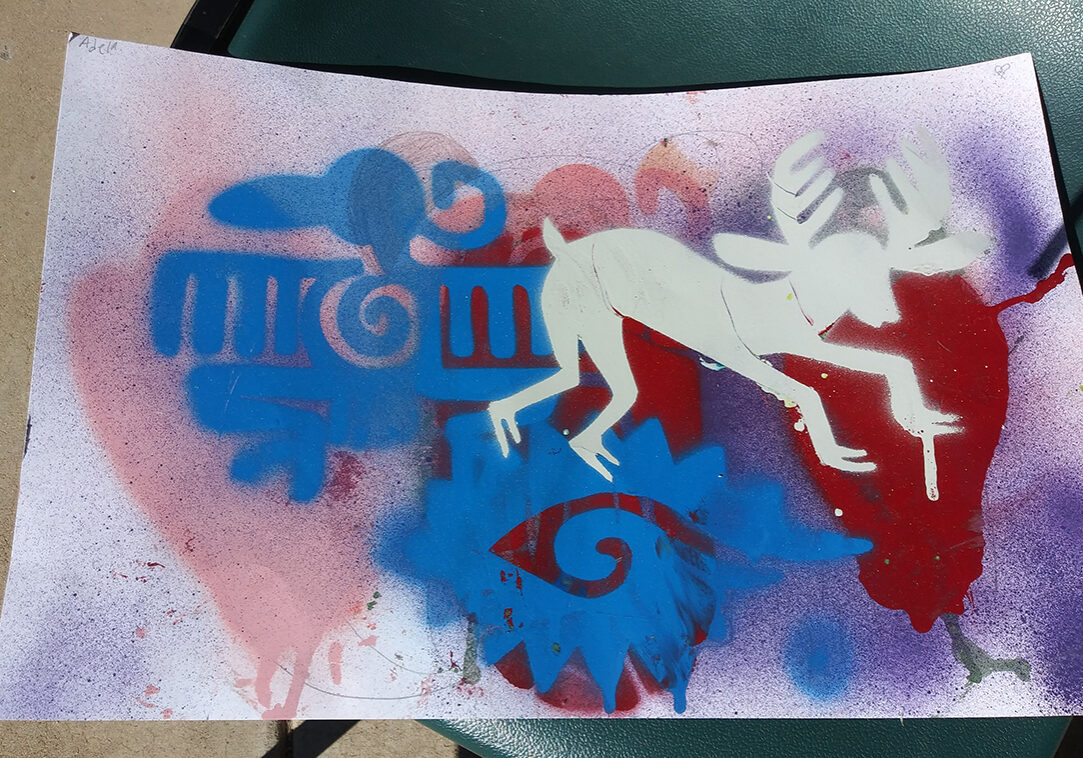


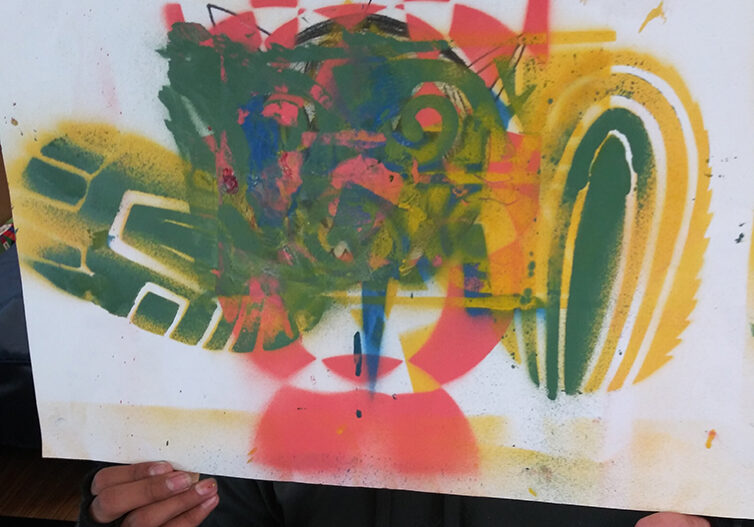
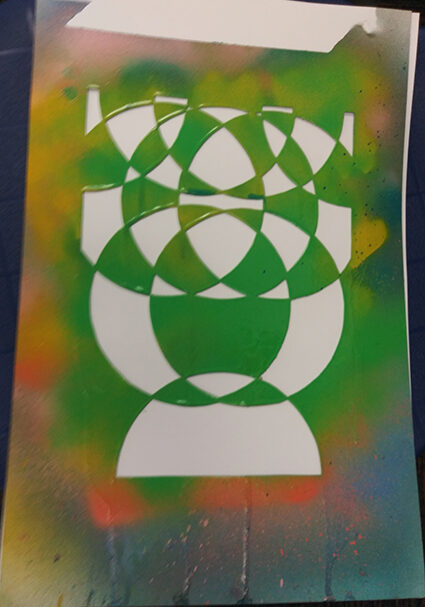
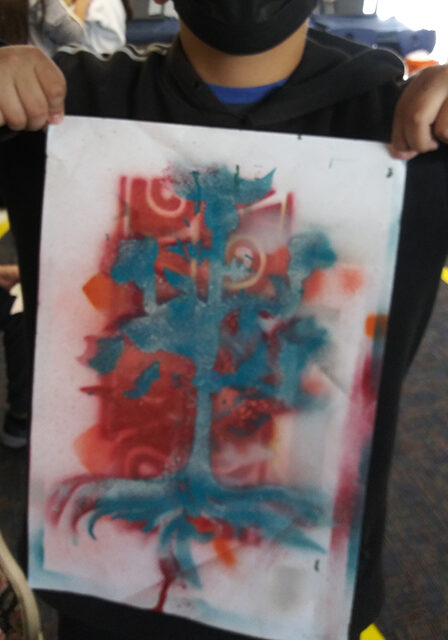
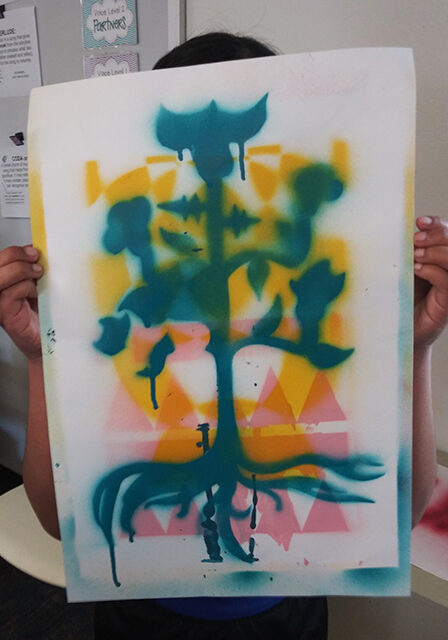

Thank you to our Funders

